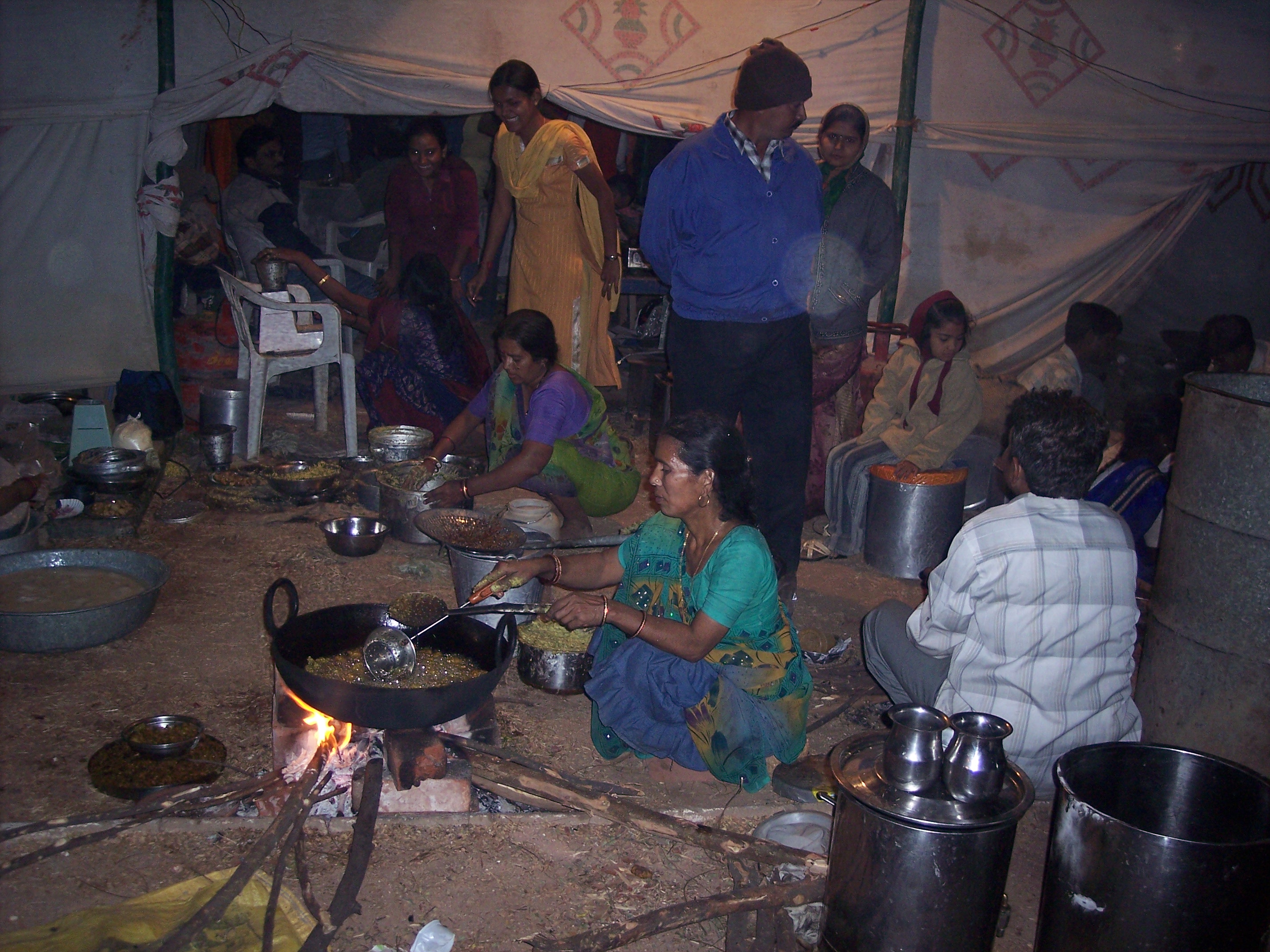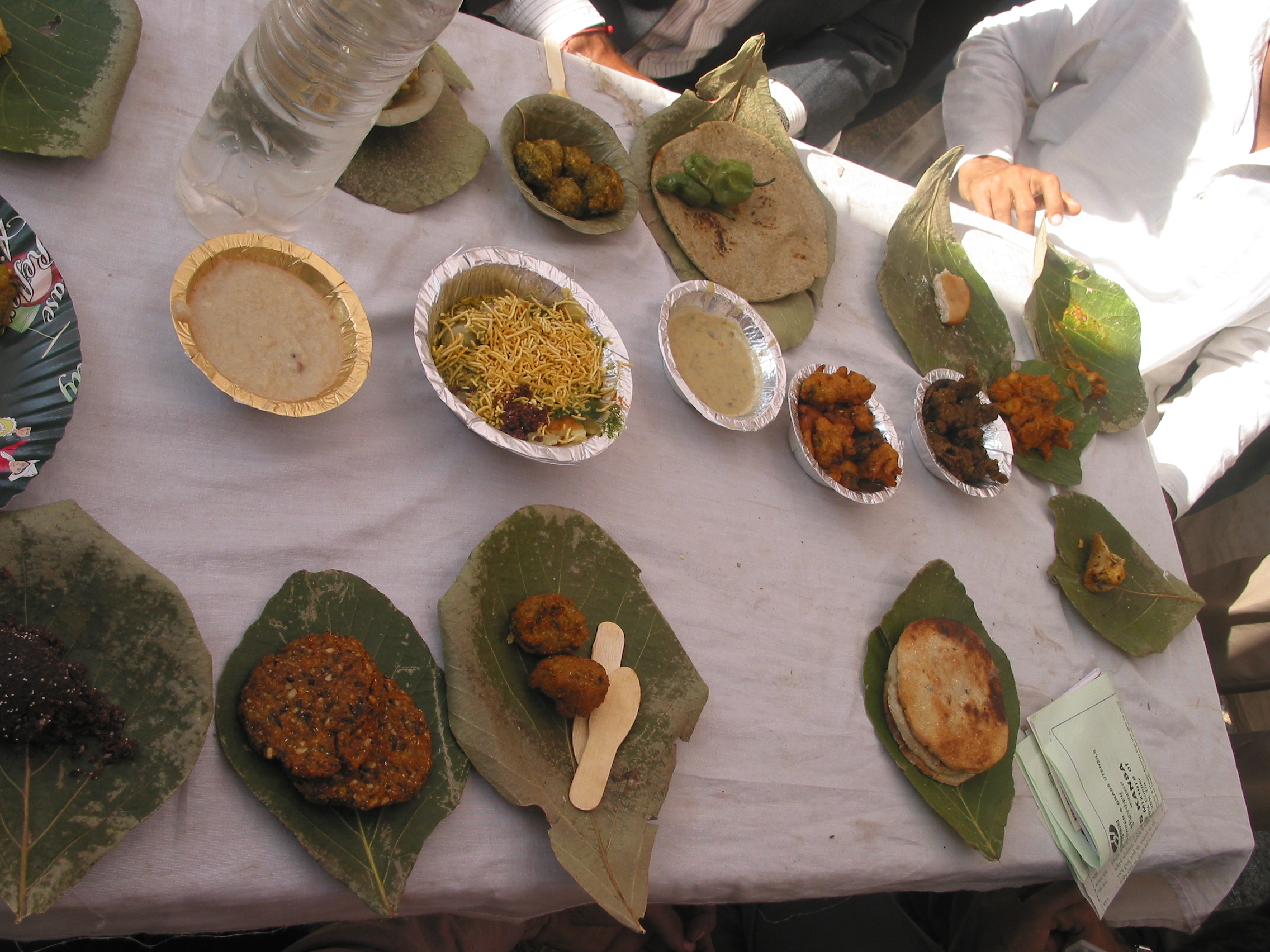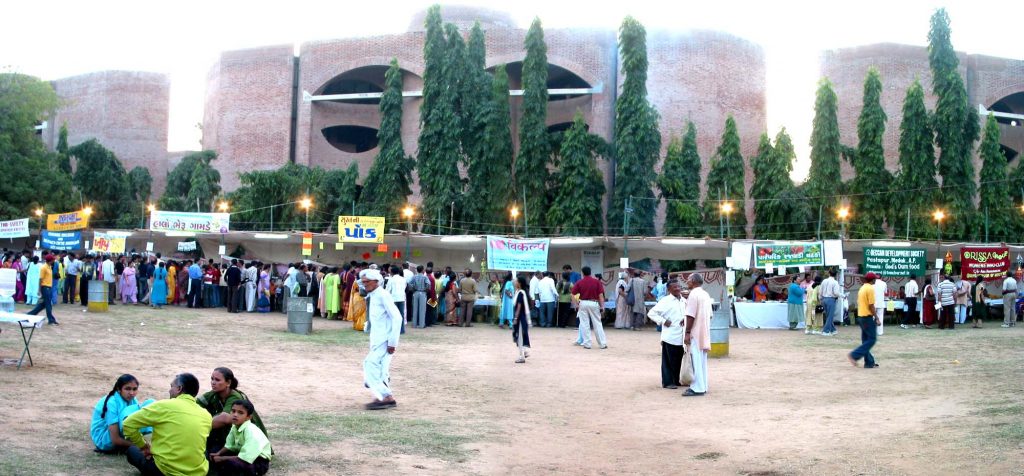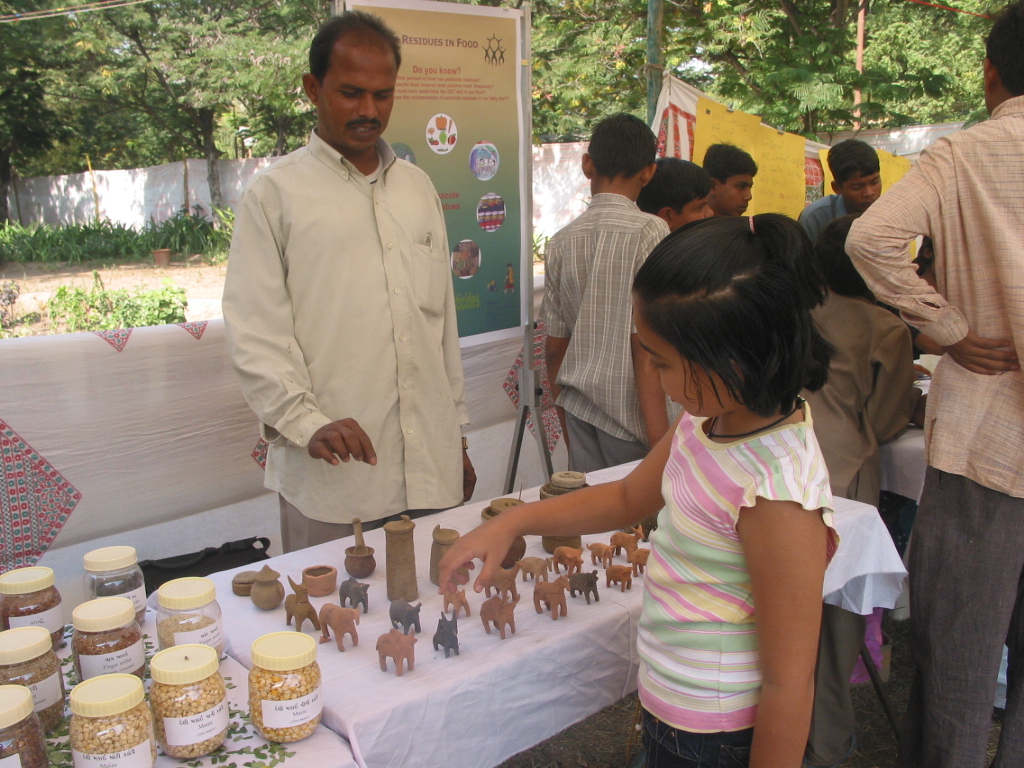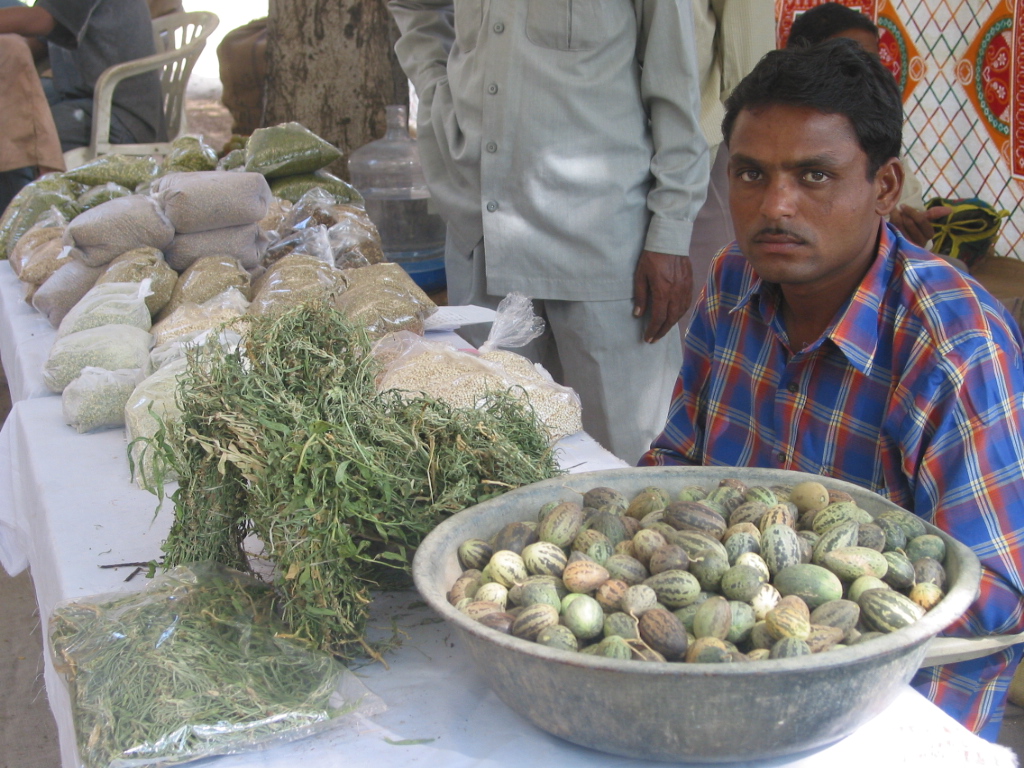1ST & 2ND TRADITIONAL FOOD FESTIVAL
(28th to 29th February, 2004)
(4th to 5th December, 2004)
“A cultural milieu to revive the forgotten tastes and hence the forgotten ties!”
Date : 28th to 29th February, 2004 & 4th to 5th December, 2004
Venue : New Campus, IIM, Vastrapur, Ahmedabad
Time : 11:00 am to 10:00 pm
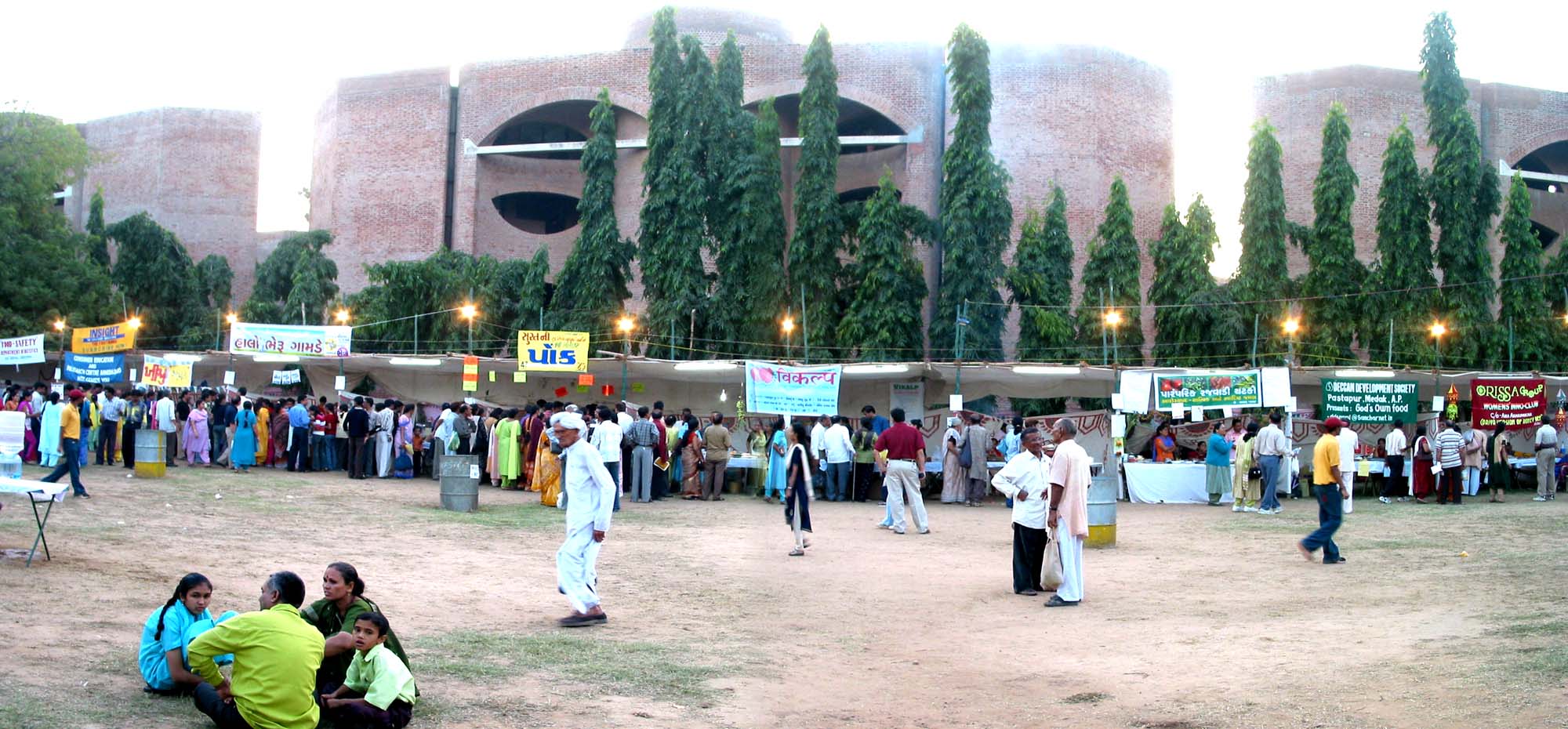
Various institutions that are a part of the Honey Bee Network (NIF, SRISTI, GIAN and IIMA) came together to organize the Traditional Food Festival at IIMA campus on February 28-29, 2004. The timing was not accidental. February 28 is the Foundation Day of NIF and thus the Festival was also a way of celebrating NIF’s commitment to diversity, local knowledge and innovations based on agro-biodiversity.
The festival focused on four objectives :
- (a) to stimulate demand of local crops and their varieties from dry regions so as to generate market based incentives for their conservation
- (b) to generate feedback from the visitors about the attributes they prefer in local varieties and also in organic food
- (c) to organize competition among women and others to identify recipes based on less common or uncultivated plants and create awareness about organic food in the cities for better consumer health as well as sustainability of soil and water use practices
- (d) to bring various institutions working for the cause of organic agriculture on a common platform
1st Sattvik – 28-29 February, 2004
Satvik 2004 – Second Traditional Food Festival proved to be a unique way of highlighting diversity in cultures and tastes. The ninety traditional recipes and dishes made of organic produce from nine states was an indication of the rich and varied cuisine of the country. With its focus on traditional and organic food, the two day festival (Dec 4-5, 2004), was able to provide a rare opportunity for the urban people to understand and appreciate use of diverse crop varieties and uncultivated plants. It emphasized the importance of ‘voluntary’ organic farming but also drew attention to often ignored ‘compulsive’ organic farmers whose poverty necessitated their dependence on organic inputs.
Around 18,000 people visited the festival during two days. It was organized by SRISTI, along with National Innovation Foundation, Grassroots Innovations Augmentation Network (GIAN), Honey Bee Network and IIMA1. There were sixty stalls – a 50% per cent increase in the number from the First Traditional Food Festival which was held on Feb 28-29, 2004. Nine states were represented – Uttaranchal, Punjab, Tamil Nadu, Kerala, Rajasthan, Orissa, Karnataka, Andhra Pradesh and Gujarat. Thus, one could taste puttus from Tamil Nadu, dudi ka halwa from Uttaranchal or arisha cakes from Orissa.
The biggest draw, however, was the khedut mandal where vegetables and farm products were on display. The large, fresh vegetables and fruits proved to be irresistible for many. For instance, about 20 kg of bijoru, a large sized fruit belonging to the citrus family, was sold during the festival. Total sales at the festival exceeded rupees eight lakhs.
The response of the visitors was overwhelming. Sunda Ram Verma, who was manning Rajasthani stall said, “So many people came to taste our dal bati choorma and pyaz kachhori. Now they all know about our Shekhawati cuisine.” Verma is the Honey Bee Network Collaborator for Rajasthan and has been involved in scouting and documenting traditional knowledge practices and grassroots innovations.
Organizations promoting organic farming and produce such as Sanskruti, Asal, Jatan Vitran Kendra and Vikalp had also put up their stalls. The Peermade Development Society (Kerala) stall sold ayurveda medicines such as thaleepatradi churnam, dashamoolambari lehyam and sahyadri dahasamini. Gandhi Vidyapeeth, Vedchhi, Gujarat had put up a stall where one could buy khadi clothes made with herbal dyes. Muslim women affected by the earthquake in 2001 had put the clothes made by them on sale. Besides this, creative games, educational activities and quizzes were also organized for children.
Another major highlight was the recipe competition which was held on Dec 4, 2004. The 25 participants mainly women from Gujarat and other states prepared dishes based on minor millets and uncultivated plants. The competition yielded a rich harvest of traditional dishes such as kele ke phool ka subzi (a dish made of banana flowers). Some had experimented with the minor millets and uncultivated plants and created new, delicious dishes. The competition was judged by Ambarben Trivedi, head of the department – food and nutrition, B Arts College, Smitaben, faculty in SLU College and B B S Chauhan, Chief Chef-Hotel Inder Residency. Kaushik Deepti with her laddoo (made of soyabean, ragi, bunti, bawta and coconut) and pula (made of jowar and soyabean) was given the first prize. The second prize went to Damayanti G Segade who had made two dishes from an uncultivated plant and pulses respectively. These were looni ki bhaji and kulche ki sabzi. Kavita Kaushik Pathak won the third prize for kele ke phool ki subzi and laddoos in which she had used the seeds of the tulsi plant.
Seven varieties of minor millets and twelve other grains were used in many recipe s. The festival also provided an opportunity for farmers, distributors and others interested in organic farming to come together. A meeting was held and various issues such as certification, marketing etc., were discussed. It was felt that all those who were involved in this field should pool their knowledge and expertise. The information which is collated could be put up on a website. The idea of a helpline which would provide information about places from where one could buy organic produce was also mooted.
A survey aimed at gauging people’s understanding of organic farming and related issues was conducted with the help of MBA and Journalism students of Rai University, Ahmedabad. The survey was a part of the ongoing research activities on organic and traditional food undertaken by SRISTI and IIMA. The focus of the survey was on aspects like awareness, preferences, attitudes and demand for genetically diverse and organic food produced by small and marginal farmers. The information collected is currently being collated and analyzed. (Honey Bee, 16(1):10-11, 2005).
2nd Sattvik – 4-5 December, 2004
Various institutions that are a part of the Honey Bee Network (NIF, SRISTI, GIAN and IIMA) came together to organize the Traditional Food Festival at IIMA campus on February 28-29, 2004. The timing was not accidental. February 28 is the Foundation Day of NIF and thus the Festival was also a way of celebrating NIF’s commitment to diversity, local knowledge and innovations based on agro-biodiversity. The festival focused on four objectives : (a) to stimulate demand of local crops and their varieties from dry regions so as to generate market based incentives for their conservation, (b) to generate feedback from the visitors about the attributes they prefer in local varieties and also in organic food, (c) to organize competition among women and others to identify recipes based on less common or uncultivated plants and create awareness about organic food in the cities for better consumer health as well as sustainability of soil and water use practices, and (d) to bring various institutions working for the cause of organic agriculture on a common platform.
The advantage of emerging demand for organic food is being harnessed primarily by gentlemen farmers who have switched to organic agriculture in the recent past. Just as rich farmers could derive greater benefit from the green revolution, there is fear that the organic food market may similarly see their dominance.
It is also important to note that several factors have led to a decline in agro-biodiversity in rural areas such as diffusion of modern varieties primarily by public agencies, changes in consumer taste, declining demand from consumers as well as from food and agro processing industry for dry land crops and their varieties, lack of public procurement and price support policy, etc. Honey Bee Network has been documenting peoples’ knowledge and innovations about biodiversity as well as other resources. As a part of an on-going research at IIMA and SRISTI, dialogues have been held with the industry, researchers and other stakeholders about incentives for in situ conservation. Since many of the local varieties are also grown organically, for lack of choice and options as poor farmers cannot afford inputs, demand for these varieties also reinforces demand for organic products.
Diversity of crops and other food items is closely linked with cultural diversity. One cannot conserve one without the other. The Traditional Food Festival, thus, also became an occasion to celebrate diversity of culture, creativity in cuisine and conservation ethic. A book of traditional food recipes in Gujarati published by SRISTI was also released on the occasion and about 250 copies were sold.
Prof. Bakul Dholakia, Director, IIMA, while inaugurating the Food Festival emphasized the importance of biological and food diversity present in our culture. He regretted that a lot of restaurants took great pride in offering Thai, Mexican or Italian food. But one would not be able to sample recipes from different regions of Gujarat in the same restaurant. He appreciated the efforts made by SRISTI and NIF which were trying to highlight the knowledge and values of informal
technologies and institutions in our villages. He said that contrary to popular perception, IIMA was not indifferent to local knowledge and diversity. In fact, considerable work had been done in this field during the last decade or so. He hoped that more faculty members and students from the Institute would join such efforts and help in conserving cultural, biological and food diversity for future generations.
Organizing the Festival
Several institutions involved in organic farming joined hands with SRISTI to organize the festival. Jatan, was one such institution which was an important part of the endeavour. It had earlier organized food festivals for organic producers in several parts of Gujarat. In all, there were 40 different stalls, primarily of food. Stalls dealing with publications related to sustainable agriculture were also there. Total sales at the festival amounted to Rs.2.8 lakh with maximum sales generated at the farmers’ market where organic producers sold their products themselves.
There were many Gandhian organizations which had put up their stalls. These provided a complete range of organic products to the consumers. Farmers from Vadodara had brought organic vegetables which proved to be extremely popular. Kutch organic farmers had brought herbal value added products made of Aloe vera and other such dry land plants. V S Hospital had put up a stall to highlight their observation (based on scientific experiments) that considerable health improvement was witnessed in specific disease groups by feeding patients with diet comprising minor millets.
One of the most popular stalls at the Festival was the stall by farmers from Surjumi village of Panchmahal district. It had recipes based on local grains such as sweet laddu (Rs.10 per piece of 40 g) made of Eleusine coracana. In addition, they sold various dishes made of local varieties of maize, Setaria italica, Paspalum scorbiculatum, Cucumis callosus, Ficus glomerata, Cucurbita pepo, Oryza sativa, Zea mays, etc.
About 14,000 people visited the festival during the two days that it was organized and consumed various food items and also bought fabrics dyed with vegetable colours and treated with herbal extracts. A recipe competition was also organized on the occasion and was judged by the executive chef of Hotel Taj Umed, faculty from Institute of Hotel Management and other local food experts.There was also considerable interest among the representatives of major hotels who had visited the food festival to present to their clients special health based food menu cards. If this caught on and became a trend, it could herald a major breakthrough in the area of conserving agro biodiversity. Demand for minor millets and other crops from hotel industry could provide incentives for conservation and production of these health crops. Nutritional information about some of the food items was also displayed but this is an area where much more research needs to be done before the next food festival.
The presence of a large number of children was a welcome sign as it translated into their becoming more aware about the idea of diversity. The media also took considerable interest in the festival and the activities like the recipe competition. Members of the media interacted with the visitors. Many distinguished citizens including eminent Gandhian leaders, scientists, High Court Judges and entrepreneurs also visited the festival. The festival generated significant appreciation from the IIMA community. Many were eager to know when the next food festival would be organized.
Awareness and demand for organic
The impact of the festival could be gauged from an on the spot survey that revealed the estimated demand for organic grains. The preference for organic food was articulated by 422 visitors who responded to the questionnaire.
Demand for wheat was about 36 tons (251 respondents), rice 16 ton (238), pearl millet (bajra) 2 tons (127), edible oil 8.6 ton (176), jaggery 3 ton (170), gram whole 2.7 ton (178), gram pulse (176), moong bean 2.4 ton (178), tur dal 4 ton (178), black gram 1.6 ton (118) and many other commodities (Figures in parentheses indicate number of respondents).
When asked how many would like to read about organic farming, more than 90 per cent showed interest. In terms of promoting organic products, majority were interested in either helping by spreading the information by word of mouth or by purchasing these products. A few were willing to help as representatives or volunteers for various activities and a couple wanted to help by singing or writing songs. More than 50 per cent of the respondents said that such a festival should be organized more often. About 20 per cent of the men and 10 per cent of the women wanted access to information as well as organic products. While evaluating various criteria for purchasing organic products, the quality of produce was given the maximum rank followed by organic certification, reliable source of supply, reasonable price and packaging. Men placed more emphasis on certification.
Majority of the respondents had come to know about the festival through media reports. Other sources included friends, hoardings on the road side and staff of SRISTI, IIMA, NIF, GIAN and through the Loksarvani newsletter. More than 70 per cent of the respondents were willing to pay 10 to 15 per cent premium, 20 per cent of the male and 11 per cent of the female respondents were willing to pay 16 to 20 per cent premium. About less than 10 per cent of the respondents (of the total 358 respondents) were willing to pay more than 20 percent premium.
Another survey had been carried out by two students — Sudipta and Vijaya of Postgraduate Programme in Agri Business Management for a second year course at IIMA. The survey was conducted essentially to study the organic food market and consumer behaviour. A sample of 40 respondents, of which one third were women, was surveyed. More than 80 per cent had monthly income of more than Rs.15,000 and 30 per cent had a professional degree. About 95 per cent defined organic food as one grown without any chemicals and 80 per cent considered organic food to have been grown with organic fertilizer and pesticides.
Hardly six per cent were aware about the procedural requirements for certification. Majority of the respondents were not willing to pay any premium of more than one or two per cent (a finding at variance from the larger sample study done at Food Festival, mentioned above). Many consumers considered the goodwill of the retailer a significantly more important factor than certification. The demand for food and vegetables was much higher than grains and the ease of availability was considered an important factor influencing purchase. Taste, trust and goodwill seemed to be the three differentiating factors.
The Food Festival was quite successful as a means of generating awareness about crops and varieties for which consumption is almost non-existent in urban areas and is going down even in rural areas. But while demand for organic food was quite high, supply was a major constraint. People’s Action for Research and Assistance to Innovation and Traditional Knowledge Holders (Parakh) has taken a major initiative in this regard.
One institution alone may not be able to handle all these goals. Certification of organically grown crops and livestock produce — a crucial issue — will require a large network of volunteer inspectors knowledgeable about agriculture to visit farmers. Much of the sourcing of organic food is currently done on goodwill basis. Sadbhav SRISTI Sanshodhan Laboratory will also have to play its role in testing soils and grains/vegetables for pesticide residues. (Honey Bee, 14(4) & 15 (1): 31- 33, 2003).
FLICKR GALLERY
